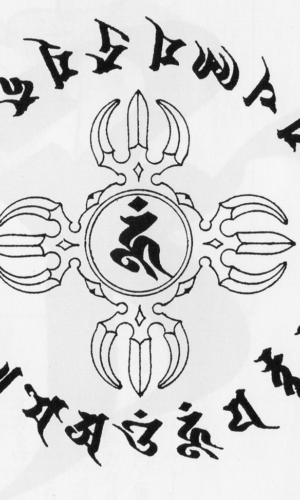
不空大灌頂光真言(ふくうだいかんぢょうこうしんごん)という密教の真言である。
It is a esoteric Buddhist mantra called Amoghavajra Abhisheka Shingon.
23の梵字から成り、最後の休止符「ウン」を加えて、合計24の梵字を連ねる。
- 発音と意味
oṃ amogha vairocana
オーン 不空なる御方よ 毘盧遮那仏(大日如来)よ
オン アボキャ ベイロシャノウ
唵 阿謨伽 尾盧左曩
mahāmudrā maṇi padma
偉大なる印を有する御方よ 宝珠よ 蓮華よ
マカボダラ マニ ハンドマ
摩訶母捺囉 麼抳 鉢納麼
jvāla pravarttaya hūṃ
光明を 放ち給え フーン (聖音)
ジンバラ ハラバリタヤ ウン
入嚩攞 鉢囉韈哆野 吽
Pronunciation and meaning
oṃ amogha vairocana
Orn, Amoghavajra, Vairocana Buddha (Vairocana)
On Avoca Beiro Shannow
Harabaritaya Om Roza
mahāmudrā maṇi padma
Those who have great marks, jewels, lotus flowers
Makabodara Mani Handma
Mother Mother
jvāla pravarttaya hūṃ
Give off the light Hoon (sacred sound)
Zimbara Harabaritaya Eun
なお、amogha(アボキャ)は不空成就如来を、vairocana(ベイロシャノウ)は大日如来を、mahā-mudra(マカボダラ)は阿閦如来を、maṇi(マニ)は宝生如来を、padma(ハンドマ)は阿弥陀如来を指すと解釈され、金剛界五仏(五智如来)に対して光明を放つように祈願している真言である。
密教ではその神秘性を保つために梵字や陀羅尼を翻訳せずに、そのまま梵音を読誦するのが通例である。日本では、平安時代から光明真言法による加持が修されてきた。
なお、上記は真言宗(智山派以外)の唱え方であり、真言宗智山派および天台宗では異なっている。
おん あぼきゃ べいろしゃのう まかぼだら まに はんどま じんばら はらはりたや うん(真言宗智山派の場合)
In addition, amagha is Amoghasiddhi, vairocana is Dainichi Nyorai, mahā-mudra is Aksho Nyorai, maṇi is Hosho Nyorai, and padma is Amida. It is interpreted as referring to Nyorai, and is a true word that prays for the five Buddhas of the Kongokai (Gochi Nyorai) to shine light.
In esoteric Buddhism, in order to maintain its mystery, it is customary to read the Sanskrit as it is without translating the Sanskrit or Dharani. In Japan, since the Heian period, adhi by the Mantra of Light has been practiced.
The above is how to sing the Shingon sect (other than the Chiyama sect), and it differs between the Shingon sect Chiyama sect and the Tendai sect.
On Abokya Beirosha no Umakabodara Mani Handoma Jinbara Hararitaya Yeah (in the case of the Shingon Buddhist Chiyama school)
